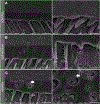Proanthocyanidin encapsulation for sustained bioactivity in dentin bioadhesion: A two-year study
- PMID: 34998601
- PMCID: PMC8828713
- DOI: 10.1016/j.dental.2021.12.024
Proanthocyanidin encapsulation for sustained bioactivity in dentin bioadhesion: A two-year study
Abstract
Objectives: To determine the long-term effect on the stability of dentin-resin interfaces after the addition of polylactide (PLA) capsules containing proanthocyanidin (PAC) to adhesive resin.
Methods: Sub-micron (SM) and micron (M) size capsules containing PACs were produced using a combination of emulsification and solvent evaporation techniques and characterized. Human dentin surfaces (n = 8) were etched (35% glycolic acid) and primed (15% enriched Vitis vinifera extract solution - VVe), followed by the application of an experimental adhesive containing 0 (control), 1.5 wt% of SM or M PAC-filled PLA capsules light cured for 40 s. A crown was built using commercial composite. After 24 h-immersion (37 °C) in simulated body fluid, specimens were serially sectioned into resin-dentin beams. Microtensile bond strength (TBS), micro-permeability and fracture pattern were assessed immediately and after 1 and 2 years. Data were statistically analyzed using two-way ANOVA and post-hoc test (α = 0.05).
Results: Polydisperse capsules were manufactured with average diameter of 0.36 µm and 1.08 µm for SM and M, respectively. The addition of capsules did not affect TBS (p = 0.889). After 2 years, TBS significantly decreased in SM (p = 0.006), whereas M showed similar initial values (p = 0.291). Overall, less micro-permeability was found in M than the control and SM group (p < 0.001). After 2 years, fractured surfaces from capsule-containing groups failed within the adhesive layer while control fractured at the bottom of the hybrid layer.
Significance: The addition of PAC-filled PLA microcapsules in a dental adhesive did not affect the bond strength while increased and sustained the protection against micro-permeability in the interface, likely due to release of PACs.
Keywords: Bioactive release; Bond strength; Polylactide capsules; Proanthocyanidins; Sustained release.
Copyright © 2021 The Academy of Dental Materials. Published by Elsevier Inc. All rights reserved.
Figures






References
Publication types
MeSH terms
Substances
Grants and funding
LinkOut - more resources
Full Text Sources

